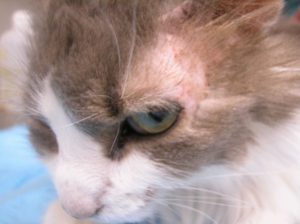factsheet – ringworm
Ringworm
(To download this factsheet please click here)
What is ringworm?
It is important to remember that ringworm is not a worm and cannot be treated by worming your cat.
Ringworm is actually a fungal infection that affects the skin. It is given the name ‘ringworm’ due to the fact that the lesion seen on the skin is generally a ring shape. The fungus that causes the infection feeds upon the dead skin and hair cells causing a circular lesion that is often inflamed with the skin on the outer edges flaky.
Why do I need to check my cat for ringworm?
Ringworm is contagious and can be transferred from people to animals and from animals to people. Young children and people with low immune responses are most susceptible. It can be transmitted by direct or indirect contact. Ringworm spores attach themselves to the shaft of hair follicles and contact with these spores can lead to the contraction of the disease. Ringworm spores can also be found in contaminated soil. Although it is often suggested that an animal has given a person ringworm, it is quite often the other way around.
What signs should I look for?
The most common clinical signs of ringworm are:
- Hair loss
- Circular patches of inflamed or flaky skin
- Itchy skin
Ringworm is most common in small kittens and older cats, long-haired cats, and cats whose immune systems are compromised. It shows up usually on the nose, toes, and whisker area. Some cats may carry the fungus without showing clinical signs.
How is ringworm treated?
Ringworm is easily treated in the home. If you suspect your cat has ringworm, see your vet. Your vet may prescribe a topical wash, ointment, tablets, or a combination of all three. Treatment can take up to six weeks to be effective.
It is important to avoid the spread of ringworm to yourself, your family, other pets, and visitors. This can be done by routinely vacuuming and dusting to remove any stray hair follicles. The use of a lint roller is especially good to remove stray hairs from your clothes.
Wash all your cat’s bedding in an antifungal wash (e.g. Canesten) and ensure anything that comes into contact with the cat is washed in the same way. Items which can’t easily be cleaned but have been heavily used by the cat (such as scratch poles) are best thrown away. Antifungal wash is available from your chemist and some supermarkets. Sunlight also kills ringworm spores so hang bedding on the line in the sun after washing it and place scratchers and toys out in the sun after cleaning.
It is also important to remember to always wash your hands after handling any animal.
Household bleach is effective at killing ringworm spores but is also highly toxic so should be used with great care. You can use diluted bleach to wipe down non-porous surfaces and floors and then thoroughly rinse/wipe down with plain water.
Treatment for ringworm in people usually involves only topical application of an anti-fungal cream. You should see your pharmacist if you suspect you have ringworm.
Here are a couple of examples of ringworm lesions on a cat:


While all care has been taken in preparing this document, it is intended to provide general information only and should not be taken as constituting professional advice. Mention of a product or business does not mean endorsement by Cat Protection.





